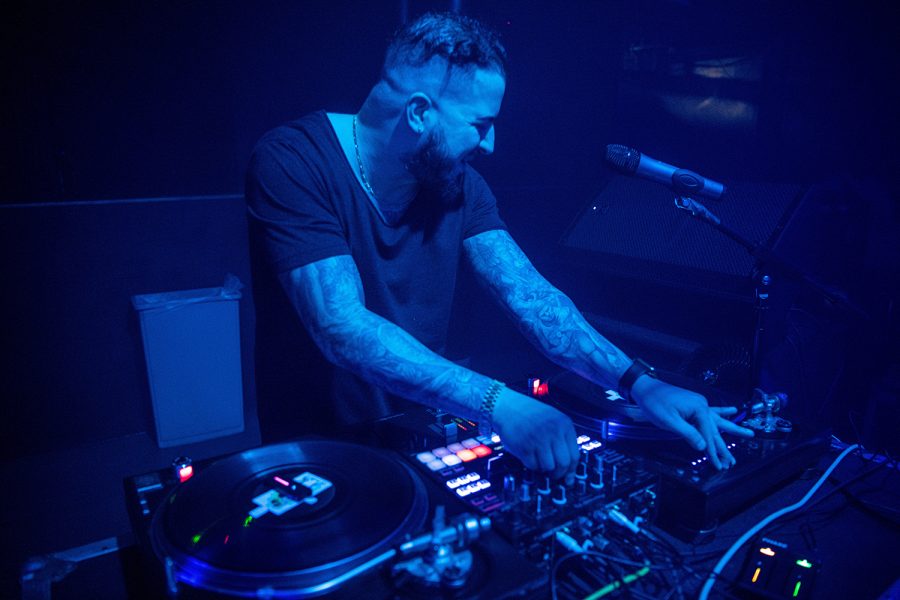121 E. College St.: Union Bar and its earlier iterations were home to many Hawkeye nightlife memories
Following the announcement of the Union Bar’s closing, The Daily Iowan looked back on the club’s history and the artists that have come since the ’70s.
Ten-cent cold, foamy beer specials, hit tunes spun by nighttime DJs, and a slick glass dance floor illuminated by kaleidoscopic colored lights — since the late 1970s, 121 E. College St. has been where arguably tens of thousands of Iowa City residents and Hawkeyes have made their fondest memories.
Now known as the Union Bar, the two-story, brick building club has featured many names over its front doors. It served as a prime-time Hawkeye tailgate spot on game days, a place to listen to live music of various genres, and a place to have a drink or three with friends.
After breaking the news that the Union Bar’s doors are now closed for good, The Daily Iowan took a look at the history behind the hot spot for live music in Iowa City.
The very best in live rock ‘n’ roll
In 1970, the Pedestrian Mall building was home to the River City Free Trade Zone, a collection of shops that created handmade goods for patrons of the ‘70s. Deemed a “freak department store” in a DI archive, the store sold records, books, drug paraphernalia, and leather goods.
According to an anonymous source from a DI archive in the ‘70s, behind a curtained window of the upstairs of the College Street building sat building owners who would “move hundreds of pounds of pot a week.”
In August of 1974, a new bar would emerge in Iowa City, finding its home on College Street.
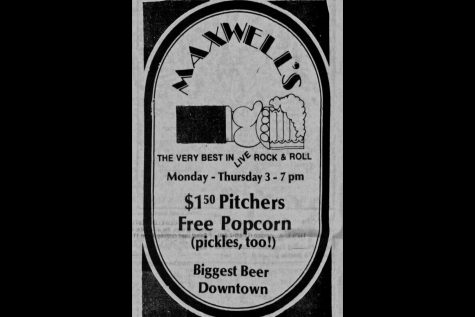
The bar was owned locally by a company called the Great American Saloon Company. Within the interior of “bare bricks and locally weathered barn wood” was the backdrop to a sunken dance floor and raised stage in the rear end of the bar, where live entertainment would play to crowds.
While advertising for “the very best in live rock ‘n’ roll,” the then-principal shareholder and manager Ken Williamson said he had planned to have bands of “five pieces and up to play top 40 music,” at Maxwell’s, according to a DI archive.
RELATED: Readings, readers, and writers: A brief history of Prairie Lights
Iowa’s legal drinking age in 1973 was 18. It was later bumped up to 19 in 1978. Williamson said at the time that the lowered age made him and other shareholders want to invest in the new bar.
One highlighted DI archive includes a 1976 cabaret described by a DI staff writer as “lamenting the absence of whisky, pretty boys, and little dollars, the painted women of Mahogonny.” Entitled “The Little Mahogonny,” the show was delivered in three parts, including compositions in German and French.
In 1979, BB King — an artist known for string bending while playing the blues — would also hit the stage at Maxwell’s.
Attracting crowds of 3,000 people in partnership with The Fieldhouse, there was plenty of room for customers, according to DI archives. Eager crowds of young adults would pay a pricey $2 cover to get into Maxwell’s on the weekends, where the bar would be playing top 40 music and disco.
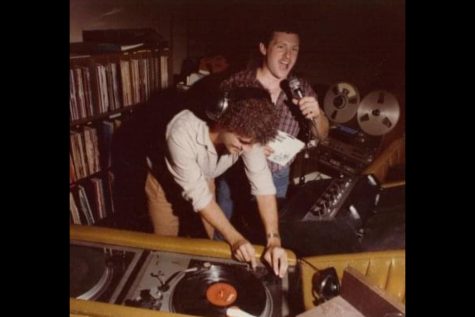
The club on College Street
Bored in the ‘80s and itching to make mayhem, local DJs such as Jeff Charmin’ Harmon and Dan Ambrisco used to move between College Street Club and the Fieldhouse bar to try and confuse drunk patrons who paid attention to who were running the tunes for the night.
In the early to mid-‘80s, Charmin’ Harmon spent most of his time as a radio DJ at KRNA playing classic rock. Under the wing of College Street Club owner Harry Ambrose, the music scene of the nightlife would soon become more oriented around dance and rock music.
“I remember a lot of these songs and playing them in their inception,” Harmon said.
Some of the Minnesota native’s top tunes of the time included “Blister in the Sun” by the Violent Femmes and “Celebration” by Kool and the Gang, he said.
As for the bar-goers who came in while school was in session, Harmon said he noticed a shift in how college students looked at music and the amount of representation behind the songs of the time.
Listen: Take a trip down memory lane with The Daily Iowan, looking at the Iowa City College Street Club’s 80’s playlist.
“People wanted to identify with something as their own — those College Street kids had their own thing,” Harmon said.
For Harmon, it was a bit of a shock seeing how downtown would light up with crowds of Hawkeyes, because he thought the area was more rural.
“I think it was probably more of the Chicago kids going there that made it more hip,” Harmon said.
As the new wave of the ‘80s began, Harmon would depart from Iowa City after getting married, always remembering the nightlife and the 2:30 a.m. ends to his shift at the loud, brick building on College Street. As he would walk out of the club after a busy night, Harmon recalls staring straight at a gyro stand and smelling the greasy food and seeing the busy Ped Mall.
For DJ Ambrisco, starting out at the College Street Club as a DJ in the late ‘80s would be a time to unwind and reconnect with friends. Ambrisco said he spun artists such as Rick James and Michael Jackson for friends, watching the Iowa City nightlife dance right in front of him on the 25-by-20-square-foot glass dance floor.
“It was fun for me because of the holidays when [people on campus] would go home and all my friends would come back from college,” Ambrisco said. “It was like a high-school reunion every Christmas with City High and West High.”
Interactive timeline of Union from 1970 to present:
For five nights a week in his undergraduate years, Ambrisco would work 5-8 p.m. on Mondays and Wednesdays and from 8 p.m. to 2 a.m. on Tuesdays, Thursdays, and Saturdays. While spinning his own tracks, Ambrisco recalls all of his friends coming out to watch him spin on the nights he worked.
“If they wanted to impress a girl, I said, ‘I got your back,’ and played the song,” Ambrisco said.
The sound system at College Street, Ambrisco said, provided for a “total party atmosphere.” He spun for packed dance floors, noting that even Hawkeye athletes made an appearance from time to time in the crowds.
“For the night, they weren’t athletes — they were just people that wanted to have fun,” Ambrisco said.
According to DI archives, College Street Club would close in December of 1989, after a forfeiture of the property to the U.S. government for its interest in the bar after trials of owners Harry Ambrose and Larry Regennitter. The two were serving sentences for conspiracy of distributing cocaine and other cocaine-related charges, leaving behind the club’s six bar stations, dance floor, and 10-cent beer specials.
The Hawkeyes of the ‘80s will always know College Street Club as the place they lived out their best moments.
“Iowa City is the best place to be, if you never want to grow up,” Harmon said.
The Union on College
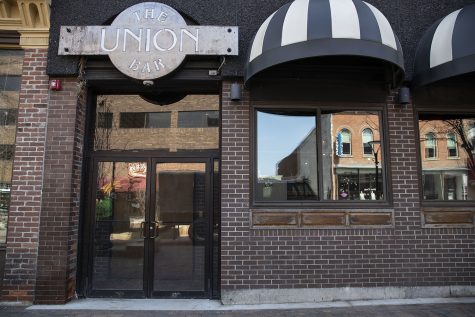
The Union Bar is seen on Tuesday, April 7, 2020. Union will be closing.
Beginning in 1993, the Union Bar was born — crowds of hundreds of Hawkeyes for its loud live music, sticky dance floor, and $1 drink specials.
In March of 1996, Union held in the alternative rock trio “The Presidents of the United States of America, performing “dorky lyrics,” the DI reported in 1996. Local artists took to the stage elevated above the sunken dancefloor some nights and the bar’s own local DJs on other evenings, Union also saw headliners such as Slipknot in Nov. 1999 for an all ages show.
For the last 13 years, “DJ Paimon” Alipour has been spinning at the venue he regards as having a hand in exposing locals to the live music scene. He said local artists have grown to become more and more accepted as time went on. Alipour said he found himself introducing crowds to local artists — and the crowds would react asking him for song titles and engaging with his music.
“Union had the reputation for the music — ownership and management really focused on that,” Alipour said.
Local music provided a cheaper option for club management, Alipour said. However, local DJs quickly found that hip-hop would soon become the No. 1 genre in music.
“When hip-hop became pop, places didn’t have a choice,” Alipour said.
With the arrival of the EDM scene’s popularity, DJs became more of the focus of the club experience, Alipour said. In particular, Iowa’s local music scene for EDM would help places such as the Union gain notoriety.
However, Alipour noticed his crowds die down in 2007, when the Iowa City City Council passed the 21-ordinance preventing persons under age 21 to enter the premises past 10 p.m.
“The 21-ordinance really changed how people experienced,” Alipour said. “I saw the minors in the crowds from 8-10 p.m. and then from 10 to about 11:30 it would be slow … and then pick back up again with the 21-plus group.”
Before the ordinance, Alipour remembers leaving Union after his set to a crowd still hanging around in the Ped Mall and enjoying themselves: now, there are few people that remain after the bar closes.
The practice of the Iowa City police conducting bar checks in the downtown area stems back to the ‘90s, according to a DI archive. Police would patrol bars checking for underage patrons and intoxicated persons every few months. According to a March 2020 bar check report from the Iowa City police, in the previous 12 months there had been 68 checks, amounting to 10 PAULAs and 95 bars-past-10 citations.
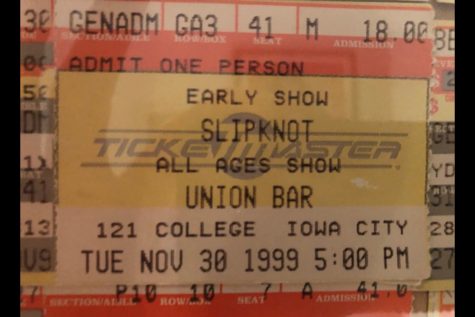
Marisa Rekemeyer, a Union frequenter, said she had gone to the bar for the music scene and party atmosphere since she was 18.
Throughout her undergraduate years at the UI, and more frequently in the years after, Rekemeyer would go for the live music atmosphere and artists such as DJ Paimon.
Now 24, Rekemeyer said the staff and artists that filled Union made the experience fun.
“Even the guys standing at the door would always dance with us before we went in… I was always the type to drop a $20 on the ground for them since they couldn’t get tipped,” Rekemeyer said.
As for the bar, the Tailwind Group purchased the three-story building for $2.9 million in 2017, the DI reported in April. This evaluation comes from one parcel that includes 117 and 119 E. College St., and another that includes 121 and 123 E. College St.
Listen: Iowa City’s top hits featured at the Union Bar on 121 E. College Street.
According to data from the Iowa City Assessor, the assessed value for both properties is $893,000 and $1.53 million, respectively. Currently, the parcels house Union and clothing store Revival.
As all nightclubs are closed in the midst of COVID-19, Alipour said he and other DJs are just trying to survive.
“Livestreaming is the way for now — there are still opportunities to tip your DJs with Venmo,” Alipour said.
For Alipour and the many others that came before him, the 121 E. College St. spot will hold some of the fondest memories with him for his life, some of which include dropping new albums the minute they were released.
Alipour said when Drake dropped an album one year, he remembers downloading it immediately for people to say, “I remember hearing that for the first time at Union.”
“It’s the most fun I’ve ever experienced — people wanted to turn up,” Alipour said.



